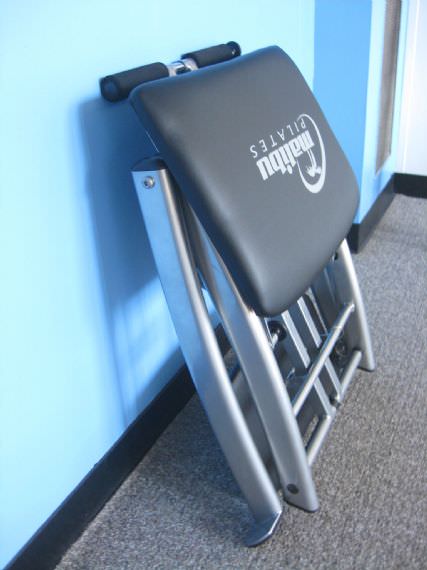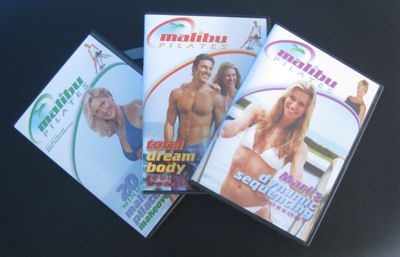|
Have you seen the infomericals for Malibu Pilates, the exercise chair endorsed by Susan Lucci? I've seen them, and they make some big promises: "Drop a dress size in 10 days! The most innovative blend of Pilates and aerobic exercise!" While I watch any fitness or weight-loss commercial with a healthy dose of skepticism, I do keep my eyes out for cool fitness products that look like they provide a good workout. As a Pilates instructor and enthusiast, I was immediately drawn to Malibu Pilates. I admit, I though it looked cool! But that's partly because I was already familiar with Pilates and the special "chair" at the center of this program. While most people are familiar with mat Pilates, they might not know that Joseph Pilates also designed several pieces of exercise equipment. The Pilates Reformer is probably the most common and widely recognized piece of Pilates equipment, but the Wunda ("wonder") chair is another. These pieces of studio equipment are pricey. Most cost $1,000 or more (not exactly cheap exercise equipment for your house). If you don't want to buy one, but want to try one, you can expect to pay AT LEAST $20 per class (usually more) to use this equipment with a certified instructor at a studio or gym. That means these amazing pieces of equipment—and the exercises you can do on them—are unaffordable and inaccessible to most people. Few gyms and studios have them, and even fewer people have the cash (or the know-how) to purchase and use these items at home. But more affordable versions of these classic designs are reaching the market for fitness enthusiasts to use at home; the Malibu Pilates chair is one of them. How does it compare to the real thing? And what kind of results can you expect? I contacted the company to review their product and they were happy to send it to us. Before you drop the cash to buy one yourself, find out what I thought of the Malibu Pilates chair and its workout DVDs. The Malibu Pilates chair and workout system was developed by Carroll Krieff, a certified Pilates instructor with more than 20 years of teaching under her belt. Not only that, she learned from one of the few "Pilates elders"—people who learned directly from Joseph Pilates himself. There are not many instructors in the world with that distinction. Knowing that Carroll was so experienced made me feel that this program was credible—not just another infomercial or "quick fix" like we see every day. She really knows her stuff! The Malibu Pilates chair itself folds up and takes up about as much space as a large stability ball. However, I think it's worth noting that to follow the workout DVDs, you need a decent amount of space in front of and behind the chair, too. For example, sometimes you lie on a mat (if you have one) in front of the chair, so you'll need space for that. But then a few minutes later you'll be standing behind the chair and then lying on it on your stomach with your legs extended behind you. This would be difficult to do in a small or crowded space without stopping the DVD to move your chair.  The Malibu Pilates chair is lightweight but solidly built. I thought it was slightly awkward to move around because of its size but far from difficult. While you can fold it up (pictured above) to carry and store it away more easily, I think that could result in unnecessary wear and tear over time, so I'd recommend keeping it set up if possible. I thought the chair, which is padded, was comfortable to sit, stand and lie on—all of which you'll do during these workouts (more on that later). At first glance, I assumed that it wouldn't be very easy to use, but I was happy to discover just how simple it was to adjust the resistance (springs) and the footbar (you can use it as one long footbar for both feet/hands or two separate ones to work each side of your body independently). This dual footbar is a plus, as not all "wunda" chairs have this feature. The printed materials that came with the chair made this easy to learn, and the workouts on the DVDs always explained how to do it (without assuming you'd remember), which I liked. So right off the bat, I felt comfortable using the chair at home in my living room. Malibu Pilates comes with four workouts (in 3 DVDs), all of which I tried. 
Overall, these DVDs provided good, classic Pilates workouts using the chair. They did offer some modifications (one person in the DVD was always modifying, which Carroll and Mari both pointed out throughout the workouts), but a few of the exercises, I think, are still way too intense for beginners to attempt; that could make some people feel defeated, but Pilates is challenging and with practice, you CAN work up to the full exercises over time. I liked the exercises and the workouts—I thought they were challenging for the core and the other muscle groups, too. Plus they were fun and different than your usual strength-training and abs exercises. My co-worker Tami got to try Malibu Pilates, too. "Honestly, I tried it and I actually love it!" she said. "I get bored with dumbbells and crunches and this actually has motivated me to do these exercises and spend more time on my core, which is generally hard for me to do." Teaching Pilates isn't easy, especially when you're on a DVD and not at home with the person, helping to explain and correct them in a way that they can understand. I think the DVDs did a good job explaining some of the important concepts and setting up each exercise. For example, Carroll would start every exercise with reminders to sit tall, engage your powerhouse, relax your shoulders down, and more. This is very important, and I'm glad these cues were included, because if you don't do these things, you won't be doing the exercise correctly or benefiting from it as much. However, it also slowed things down a little too much for me—and definitely takes away from any type of "cardio" that this workout plan promises. As you progress, you'd know to do these things and you could probably move from exercise to exercise more quickly to avoid downtime. Better yet, once you really learn the exercises and the proper form, you could blast through these workouts on your own and be more likely to elevate your heart rate than by following the DVDs. Overall, I'd recommend Malibu Pilates to a Pilates enthusiast who wants to use a Pilates chair at home without breaking the bank. Malibu Pilates is pricey—over $300 for the chair and the DVDs (when you read the fine print upon ordering at www.MalibuPilates.com, you pay $14.95 plus $29.95 S&H, plus six additional monthly payments of $49.95). But that's a fraction of the cost of the studio equipment ($1,000 and up) and it'll save you money if you don't want to pay for classes at a studio. As to whether it'll help you lose inches fast and flatten your belly, I'd say to exercise your best judgment. Infomercials make lots of claims to entice you to buy and this one is no exception. The results you see on the infomercial might not be typical, but I firmly believe that if you commit to this exercise program, coupled with a good diet, additional cardio and consistency (all of which are recommended and detailed in the Malibu Pilates package you'll receive), you could very well reach your goals. After all, we see people reach amazing goals all the time at SparkPeople by incorporating these same principles. Do you think the Malibu Pilates infomercials are enticing? Would you like to try the Malibu Pilates chair? |
Popular EntriesMore From SparkPeople |




.png)







.jpg)


